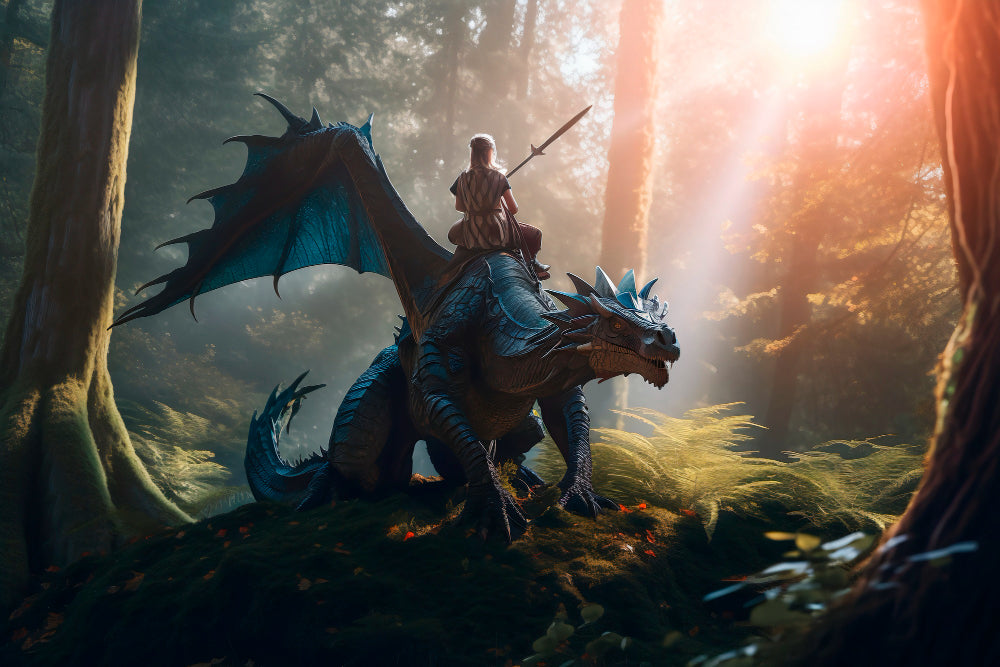Level Up Your Game with Trendy 3D Art Styles

In the ever-evolving realm of digital entertainment, staying ahead of the curve is not just an option; it's a necessity. There are several ways to achieve this, 3D art styles being one of them. Whether you're a passionate gamer, a game developer, or simply someone who appreciates the aesthetics of video games, you've likely noticed the fascinating evolution of 3D art styles. These 3D art styles have played a pivotal role in enhancing the visual appeal of video games, making them more immersive and captivating than ever before. In this comprehensive guide, we delve into the world of 3D art styles for video games, exploring their diversity, impact, and the mesmerizing beauty they bring to the gaming industry.
What Are 3D Art Styles?
3D art styles encompass a broad spectrum of artistic techniques used in video game design and animation. Unlike traditional 2D art, 3D art brings depth and dimension to the digital canvas, creating a lifelike visual experience for gamers. These styles serve as the foundation for building visually stunning virtual worlds that players can immerse themselves in. 3D art styles also involve the manipulation of lighting and shading techniques to simulate the effects of real-world physics, enhancing the sense of realism within virtual environments. These styles often rely on advanced software tools and 3D modeling techniques to sculpt intricate characters, objects, and landscapes, enabling artists to create intricate and detailed worlds. Furthermore, 3D art styles often incorporate dynamic elements such as fluid simulations for water, smoke, and fire, as well as physics-driven interactions between objects. This dynamic aspect adds an extra layer of interactivity and immersion to video games and animated films, allowing for realistic reactions and behaviors within the digital realm.

The Types of 3D Art Styles
The world of 3D art is incredibly diverse, with numerous sub-genres and styles to explore. Some notable 3D art styles include:
1. 3D Animation Art Style
3D animation art style is renowned for its ability to breathe life into characters and objects within a game. This style involves the creation of fluid, realistic movements, making characters appear as if they were part of an animated film. Games like "The Legend of Zelda: Breath of the Wild" exemplify this captivating art form.
Creating a 3D animation art style requires a sophisticated blend of skills, including character rigging, motion capture, and meticulous attention to detail in modeling and texturing. The goal is to bridge the gap between the digital and the real, crafting a narrative that players can emotionally connect with. It's a testament to the artistry and technical prowess of game developers and animators who can harness this style to create truly captivating and immersive interactive experiences.
2. Low Poly Art Style
The low poly art style takes a minimalist approach, using a limited number of polygons to create simple yet charming game environments. Different games have popularized this art style, proving that less can indeed be more when it comes to aesthetics.
Low poly art is not just about limiting the complexity of models; it also often incorporates vibrant, bold colors and uses clever texturing to create depth and detail. This minimalist approach has found its place not only in gaming but also in various forms of digital art, virtual reality experiences, and architectural visualization. One of the advantages of the low poly art style is its efficiency in terms of performance. Since it uses fewer polygons, it can run smoothly on a wide range of hardware, making it accessible to a broader audience. Additionally, its accessibility has led to a resurgence of interest in game development among indie developers and artists, who appreciate the creative freedom it offers without the technical complexities of high-poly, realistic 3D graphics.
3. Realistic 3D Art Style
Realistic 3D art style is characterized by meticulous attention to detail and an emphasis on creating lifelike visuals. This style aims to replicate real-world objects and environments with stunning accuracy, often found in simulation games and CGI-heavy films.
In realistic 3D art, artists and designers use advanced techniques and technologies to capture the nuances of the physical world. This includes highly detailed textures, realistic lighting and shading, and even physics simulations for things like cloth, water, and particles. Simulation games like flight simulators, racing games, and architectural walkthroughs often leverage the realistic 3D art style to provide players with an authentic and educational experience. In these contexts, the attention to detail extends to the physics and behavior of objects, vehicles, and environments, ensuring that everything behaves as it would in the real world. On the downside, this 3D art style can be time-consuming and technically challenging.
4. Sci-Fi and Futuristic 3D Art Style
Sci-fi and futuristic 3D art transports players to otherworldly realms filled with advanced technology and otherworldly structures. One of the defining features of this art style is its emphasis on sleek, cutting-edge designs. In the sci-fi and futuristic 3D world, you'll often encounter an abundance of sleek and polished surfaces, intricate machinery, and architecture that seems plucked from a technologically advanced future. These designs can range from spaceships that appear to defy the laws of physics to metropolises that are both awe-inspiring and intimidating.
The Sci-Fi and Futuristic 3D art style allows artists and designers to let their imaginations run wild. It's a realm where fantastical technology and innovative concepts can take center stage. This style is often associated with genres like cyberpunk, where dystopian cityscapes and neon-lit streets blend seamlessly with futuristic gadgets and cybernetic enhancements. In video games and movies, the Sci-Fi and Futuristic 3D art style is instrumental in creating immersive and engaging experiences. Moreover, the Sci-Fi and Futuristic 3D art style isn't just about aesthetics; it often serves as a backdrop for exploring complex themes related to the consequences of advanced technology, artificial intelligence, and the human condition in an ever-evolving world. It invites audiences to contemplate the potential challenges and wonders of a technologically advanced future.
5. Fantasy 3D Art Style
Mythical creatures and enchanting landscapes characterize fantasy 3D art styles. It features imaginative character designs, intricate world-building, and epic adventures. One of the hallmarks of the Fantasy 3D art style is its imaginative character designs. In these fantastical worlds, you'll often encounter a diverse array of characters, ranging from brave heroes and heroines to fearsome monsters, wizards, and mythical beings. These characters are meticulously crafted with unique appearances, abilities, and backstories, adding depth and richness to the storytelling.
In addition to character design, Fantasy 3D art places a strong emphasis on world-building. Game developers and artists in this genre invest a tremendous amount of effort in creating expansive and richly detailed game worlds. These landscapes can include medieval kingdoms, enchanted forests, ancient ruins, and mystical surroundings. The goal is to make the game world feel like a living, breathing entity with its own history, culture, and lore. This genre offers players the opportunity to embark on grand quests, engage in battles with legendary villains, and uncover the hidden secrets of their fantastical worlds. The storytelling often explores themes of heroism, magic, destiny, and the eternal struggle between good and evil, captivating audiences of all ages. That is what makes fantasy 3D art style timeless.

The Influence of 3D Art Styles on Video Games
The impact of 3D art styles on video games cannot be overstated. 3D art styles not only elevate storytelling but also enable developers to craft narratives that rival those of other media forms, allowing players to emotionally connect with characters and immerse themselves in intricately designed worlds. These visual elements act as powerful tools for conveying the game's narrative, reinforcing the importance of visual storytelling in the gaming landscape. Furthermore, 3D art styles facilitate the creation of interactive, dynamic environments, significantly enhancing the player's engagement. Whether it's solving puzzles, exploring vast open worlds, or experiencing intense combat, these visual elements are instrumental in shaping how players interact with the game world. Captivating 3D art styles serves as the initial hook, drawing gamers into the game, which is imperative in today’s competitive gaming landscape. As such, developers keenly understand the importance of creating games with striking and unique art styles to pique player interest and generate excitement.
Additionally, 3D art styles have played a pivotal role in diversifying game genres and experiences. These styles accommodate a wide spectrum of preferences, from hyper-realistic simulations to abstract and stylized worlds, ensuring that the gaming industry can cater to a broad audience with varying tastes and interests. This inclusivity has been a driving force behind the industry's growth and evolution.
Lastly, the pursuit of more advanced 3D art styles has spurred significant technological advancements within the gaming realm. The demand for enhanced graphics, improved processing power, and sophisticated rendering techniques has resulted in the development of cutting-edge gaming hardware and graphics engines. Consequently, these technological strides have empowered game developers to create increasingly immersive games with different types of 3D art styles.
How to Level Up Your Game with 3D Art Styles?
As a game developer or designer, mastering the art of 3D design can be a game-changer. It allows you to craft game worlds that resonate with players long after they've put down the controller. Consider the following tips to level up your game with 3D art styles:
1. Stay Informed
Keep up with the latest trends and developments in 3D art. The gaming industry evolves rapidly, and staying informed ensures your work remains relevant and appealing. This will help you gather more information about a particular 3D art style and how you can make the most of it.
2. Experiment
It is advisable to experiment with different 3D art styles. Uniqueness is appreciated in today's gaming world. As you experiment with different types of 3D art styles, you might stumble upon something unique that sets your game apart.
3. Storytelling Through Art
The use of 3D art to enhance storytelling is the way to make a mark in the gaming world. A well-designed game world can immerse players in your narrative, making it a truly unforgettable experience. Therefore, never underestimate the power of 3D art styles.
4. Optimization
Balance visual effects with performance optimization. While breathtaking graphics are essential, they should not come at the cost of smooth gameplay. Choose your 3D art style accordingly and ensure optimization.
5. User Feedback
Listen to player feedback and adapt your art style accordingly. Engaging with your audience can lead to valuable insights and improvements. This will give an insight into a particular 3D art style and how it is performing in the gaming world.

Conclusion
In the ever-evolving landscape of video games, 3D art styles are the outlets of creativity. Different types of 3D art styles are forming the foundations of different game genres and are captivating a wider audience. Whether you're a creator or a gamer, understanding and appreciating the diversity of 3D art styles can elevate your experience in this field. It's not just about pixels and polygons; it's about the effect 3D art styles can create in the gaming world. They can set apart any game with enchanting visuals and captivating narratives, which will ultimately lead to more player retention. So, choose your 3D art style today and build unforgettable experiences.
-
Posted in
3d art styles, 3d game




